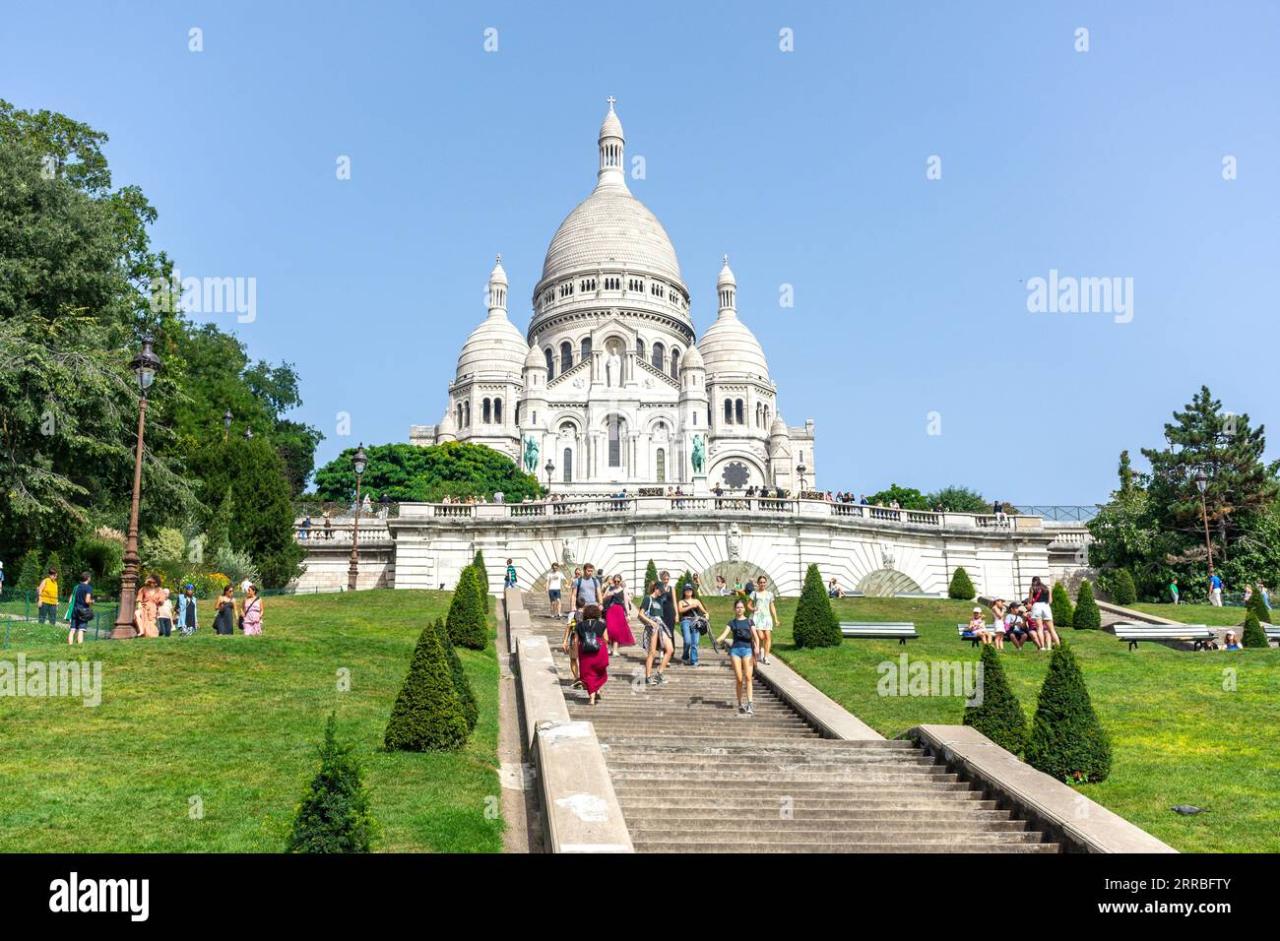Perched atop the iconic Montmartre hill, overlooking the sprawling city of Paris, stands the majestic Basilique du Sacré-Cœur. This gleaming white basilica, with its distinctive Romano-Byzantine architecture, is not only a prominent landmark on the Parisian skyline but also a place of deep spiritual significance and artistic beauty. Attracting millions of visitors each year, it begs the question: is this architectural marvel free to visit? The answer is both yes and no, and understanding the nuances can help you plan your visit accordingly.
A Historical and Spiritual Tapestry
Before delving into the accessibility of the basilica, it’s essential to understand its rich history and the profound motivations behind its construction. The Basilique du Sacré-Cœur, meaning the Basilica of the Sacred Heart, was conceived in the aftermath of the Franco-Prussian War (1870-1871). France suffered a humiliating defeat, and the nation was deeply divided. The idea for the basilica was proposed as a national vow to atone for the sins that were believed to have led to France’s misfortunes. It was envisioned as a symbol of hope, reconciliation, and unwavering faith in the Sacred Heart of Jesus.
The project was officially sanctioned by the National Assembly in 1873, and construction began in 1875, continuing for nearly half a century. The basilica was finally consecrated in 1919, after the end of World War I. The architectural design, spearheaded by Paul Abadie, drew inspiration from Romanesque and Byzantine styles, resulting in a unique and striking structure. Its bright white travertine stone, quarried from Château-Landon, contributes to its luminous appearance, especially when bathed in sunlight.
Architectural Marvels and Artistic Treasures
The Basilica du Sacré-Cœur is a feast for the eyes, both inside and out. Its exterior is dominated by four domes, the largest of which soars to a height of 83 meters. The facade is adorned with sculptures and bas-reliefs depicting scenes from the life of Christ and the history of France.
Inside, the basilica is equally impressive. The vast interior space is illuminated by stained glass windows that cast colorful patterns across the walls. The focal point of the basilica is the apse, which houses one of the world’s largest mosaics. This breathtaking mosaic, titled "Christ in Glory," depicts Jesus Christ with outstretched arms, surrounded by saints, angels, and historical figures.
The basilica also houses a large pipe organ, built by Aristide Cavaillé-Coll’s successor, Charles Mutin. Its powerful and resonant sound fills the basilica during services and concerts.
Free Access to the Sacred Heart
The good news for budget-conscious travelers and those seeking a spiritual experience is that access to the main basilica is completely free. You can enter the basilica and admire its stunning architecture, the magnificent mosaic, and the overall atmosphere of reverence without paying any admission fee. You can attend mass, light a candle, or simply sit in quiet contemplation.
This free access allows anyone, regardless of their financial situation, to experience the beauty and spirituality of the Basilique du Sacré-Cœur. It reflects the basilica’s original intention as a place of prayer and reconciliation for all.
The Dome and the Crypt: Where Fees Apply
While entry to the main basilica is free, there are two specific areas within the Sacré-Cœur where an admission fee is charged:
- The Dome: For a small fee, you can climb the 300 steps to the top of the dome. This climb is not for the faint of heart, but the reward is well worth the effort. From the dome, you can enjoy panoramic views of Paris that are simply unparalleled. On a clear day, you can see landmarks such as the Eiffel Tower, the Louvre Museum, and Notre Dame Cathedral.
- The Crypt: Located beneath the basilica, the crypt is a network of chapels and tombs. It houses the tombs of prominent figures associated with the construction of the basilica, including the architects Paul Abadie and Lucien Magne. The crypt also contains a collection of religious artifacts and sculptures. A small fee is required to enter the crypt.
Why Pay for the Dome and the Crypt?
The fees charged for accessing the dome and the crypt are used to help maintain the basilica. The Sacré-Cœur is a historic building that requires ongoing repairs and upkeep. The funds generated from these admissions help to ensure that the basilica remains in good condition for future generations.
Planning Your Visit: Tips and Considerations
- Timing is Key: The Basilique du Sacré-Cœur is a popular tourist destination, so it can get crowded, especially during peak season (summer) and on weekends. To avoid the crowds, try to visit early in the morning or later in the afternoon. Weekdays are generally less crowded than weekends.
- Dress Code: As a place of worship, the Basilique du Sacré-Cœur has a dress code. Visitors are expected to dress modestly. Shoulders and knees should be covered. Hats should be removed before entering the basilica.
- Photography: Photography is allowed inside the basilica, but flash photography is prohibited.
- Security: Be aware of your surroundings and take precautions against pickpockets, especially in crowded areas.
- Accessibility: The Basilique du Sacré-Cœur is located on top of a hill, so there are several steps leading up to the entrance. A funicular is available for those who have difficulty climbing the stairs. There is also a bus that stops near the basilica.
- Combined Visit: Montmartre has a lot to offer. Consider combining your visit to the Sacré-Cœur with a stroll through the charming streets of Montmartre, a visit to the Place du Tertre (where artists create and sell their work), or a performance at the Moulin Rouge.
Beyond the Basilica: Exploring Montmartre
Montmartre, the neighborhood surrounding the Basilique du Sacré-Cœur, is a treasure trove of art, history, and culture. This hilltop district was once a haven for artists, writers, and musicians. It was home to famous figures such as Pablo Picasso, Salvador Dalí, and Vincent van Gogh.
Today, Montmartre retains its bohemian charm. Its narrow, winding streets are lined with art galleries, cafes, and boutiques. The Place du Tertre is a bustling square where artists create and sell their work. The Moulin Rouge, a legendary cabaret, is located at the foot of Montmartre hill.
Conclusion: A Free Spiritual and Artistic Experience Awaits
The Basilique du Sacré-Cœur de Montmartre is a magnificent monument that offers a unique blend of spiritual significance, architectural grandeur, and artistic beauty. The fact that access to the main basilica is free makes it an accessible destination for everyone, regardless of their budget. While a small fee is required to climb the dome and explore the crypt, the opportunity to experience the basilica’s awe-inspiring interior and its atmosphere of peace and reverence is a gift that is freely given.
So, whether you are a devout Christian, an art enthusiast, or simply a traveler seeking breathtaking views of Paris, a visit to the Basilique du Sacré-Cœur de Montmartre is an experience that you will not soon forget. Combine your visit with a stroll through the charming streets of Montmartre, and you will have a truly unforgettable Parisian adventure. It’s a place where faith, art, and history converge, creating a lasting impression on all who visit.

